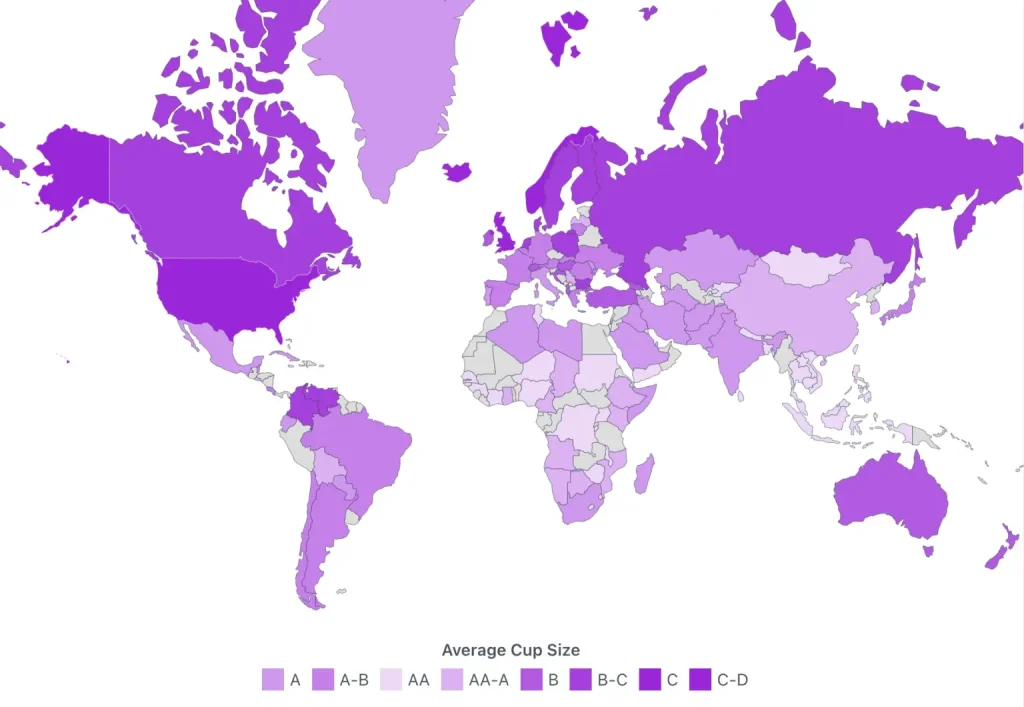
A global analysis recently revealed the countries with the largest average breast sizes — and while the United States ranked near the top globally, a closer look at African countries reveals some intriguing regional trends of their own.
The original report, published by the World Population Review, analyzed the average bust size of 108 countries worldwide, comparing both cup and band sizes in relation to body mass index (BMI). Using that global dataset, we’ve filtered and focused exclusively on the top 10 African nations by average breast size to better understand how the continent measures up.
Africa’s Biggest Breast Sizes by Country (Top 10)
| Rank | Country | Average Cup Size | Band Size Equivalent | Relative Index Score |
|---|---|---|---|---|
| 1 | South Africa | B | A | 29.5 |
| 2 | Libya | B | A | 29.5 |
| 3 | Algeria | B | A | 26.5 |
| 4 | Botswana | B | AA–A | 26.3 |
| 5 | Zimbabwe | A | AA | 25.4 |
| 6 | Ghana | B | AA–A | 25.2 |
| 7 | Cameroon | B | AA–A | 25.1 |
| 8 | Kenya | A | AA–A | 24.4 |
| 9 | Ivory Coast | A | AA | 24.2 |
| 10 | Angola | B | AA–A | 24.2 |
“Breast size is unique to each woman and is influenced by several factors, including genetics, nutrition, body weight and BMI, age, and overall fitness,” the report authors noted. “Cup size alone does not tell the full story — band size and body composition play major roles in determining breast volume.”
South Africa and Libya tied for the top spot in Africa, each posting a Relative Index Score of 29.5, driven by fuller chest volumes relative to BMI. Both countries had an average cup size of B and a band size equivalent of A, placing them close to global leaders like the US and UK.
In third place, Algeria posted a strong index of 26.5, reinforcing a pattern among North African countries of higher average volumes — a trend likely influenced by genetics and regional body types.
Botswana ranked fourth with a Relative Index Score of 26.3, the highest among Sub-Saharan nations. Despite more modest cup sizes, a relatively fuller underbust circumference boosted its overall ranking.
Zimbabwe came in fifth at 25.4, followed closely by Ghana (25.2) and Cameroon (25.1). These West and Southern African countries displayed similar BMI-to-bust profiles, indicating comparable body structure patterns.
East Africa’s Kenya placed eighth with a score of 24.4, while Ivory Coast and Angola tied at 24.2, rounding out Africa’s top ten.
As the global report emphasized, breast size correlates closely with BMI. “Countries with higher average BMIs tend to report larger breast sizes,” the authors explained. “Since much of the female breast is composed of fatty tissue, even a small increase in BMI can result in significantly more volume.”
Still, the authors warned that cup size alone doesn’t paint a complete picture. “A 36B and a 32B may wear the same cup letter, but their volumes are not the same,” they explained. “The difference between the band and bust measurement — not the letter — is what truly defines the size.”
This focused look at African nations reveals how body composition, genetics, and lifestyle combine in unique ways across regions. While African averages may differ from Western countries, they reflect the natural diversity of body types across the continent.
